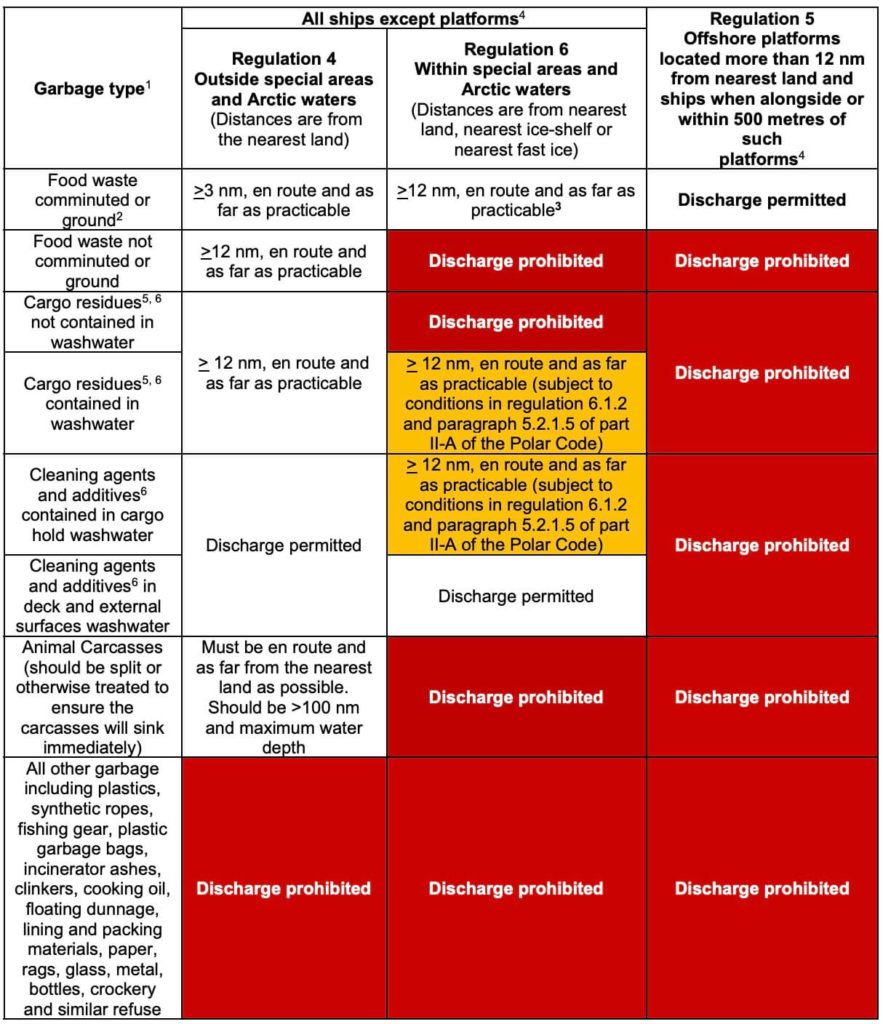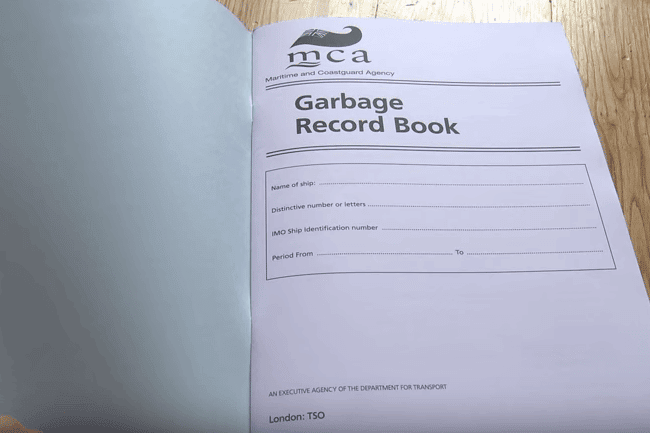The garbage produced onboard ships needs to be properly disposed of as stated by the MARPOL Annex V. Garbage is one of the several reasons which have been responsible for marine pollution at sea.
As per the MARPOL Annex V, the garbage produced on the ship includes domestic, operational and all other types of victual waste, excluding fresh fish and parts thereof, generated during the normal operation of the ship and liable to be disposed of continuously or periodically except those substances which are defined or listed in other Annexes to the present Convention.
Stringent rules and regulations have therefore been made and implemented in order to prevent ships from disposing waste at the sea.
According to MARPOL Annex V, this garbage regulation applies to all the ships which are operating in the marine environment, including merchant ships, fixed or floating platforms, non-commercial ships like yachts, pleasure crafts, ferries etc.
All vessels need to display instructions along with placards to inform the ship’s crew and passengers regarding disposal requirements of garbage.

Credits: Videotel/YouTube
Moreover, it is mandatory that every ship of 400 GWT and above which is certified to carry 15 passengers or more must carry a Garbage Management Plan (GMP) and a Garbage Record Book.
On 01st March 2018, the MEPC committee introduced an amendment to MARPOL Annex V which differentiates between hazardous and non-hazardous waste. Post this amendment, the Garbage Record Book is divided into two parts considering those ships which carry cargoes in bulk solid form and with a new category inclusion of e-waste produced on ships.
Classes of Garbage on Ships
Garbage onboard ships are classified into various categories in order to facilitate easy handling and disposing of.
Garbage on ships is classified into the following:
- Plastics
- Floating dunnage, lining, and packing material
- Ground down paper products, rags, glass, metal bottles, and crockery.
- Domestic waste
- Incinerator ash
- Normal paper products, rags, oily rags, glass, and metal scrap
- Operational waste
- Animal Carcasses onboard livestock carrier
- E-Waste
- Cooking oil waste produced in the galley
- Cargo residues onboard ships carrying solid cargo in bulk which are not harmful to the marine environment (Non-HME)
- Cargo residues onboard ships carrying solid cargo in bulk which are harmful to the marine environment (HME)
It is to note that Annex V of MARPOL prohibits disposal of plastic anywhere at the sea. It also restricts disposable of any form of garbage in coastal and “special areas”.
Special Areas under MARPOL Annex V
- Mediterranean Sea
- The Baltic Sea
- The Black Sea
- The Gulf Areas
- Antarctic Area
- The Red Sea Area
- The North Sea
- The Wider Caribbean Region
Garbage Disposal Inside Special Areas
Garbage disposal inside special is totally restricted apart from:
- Food waste to be disposed at more than 12 nautical miles
- In wider Caribbean region food wastes comminuted more than 3 nautical miles
According to MARPOL, ships must not enter the Antarctic area unless they have sufficient capacity for the retention of all garbage on board and also have arrangements for the discharge of retained garbage at a reception facility after leaving the area. No garbage whatsoever, not even food wastes, should be discharged into the Antarctic area.
Garbage Disposal outside Special Areas
A general overview of garbage disposal outside special areas is provided below:
- Disposal of plastic is totally prohibited.
- Floating material to be disposed at more than 25 nautical miles from the nearest land.
- Food, Crockery, bottles, rags, meals, cans etc. to be disposed at more than 12 nautical miles from the nearest land.
- Food, crockery etc. can be disposed at more than 4 nautical miles from the nearest land.

Source: IMO.org
For this regulation, there are no certification or approvals necessary, however, it is mandatory for all ships and the following requirement to be fulfilled by the ships under MARPOL Annex V:
- Placards posted on board noting the discharge requirements
- A Garbage Management Plan
- A Garbage Record Book
According to MARPOL Annex 5, all governments should provide reception facilities at ports and terminals for reception of garbage.
A ship must display placards providing details of garbage discharge requirements if it is ≥12 m long and also applicable for fixed and floating platforms.
Garbage Management Plan (GMP)
A Garbage Management Plan details procedures for collecting, processing, stowing, and disposing of the garbage onboard ships. The plan also mentions a designated person who is in charge of carrying out the plan.
This is Applicable to ships ≥100 GT or certified to carry 15 or more persons, and fixed and floating platforms.
Click here to know more about Garbage Management Plan (GMP) in detail.
Know how to develop a Garbage Management Plan here.
Garbage Record Book
The Garbage Record Book consists of all the entries that are to be made while disposing or discharging garbage.

Credits: Videotel/YouTube
All the ships which are ≥400 GT or certified to carry 15 or more persons, and fixed and floating platforms must carry a garbage record book.
The Ships under appendix II of MARPOL Annex V now needs to carry two garbage record book:
- Part I for all garbage other than cargo residues, applicable to all ships
- Part II for cargo residues only applicable to ships carrying solid bulk cargo
In the GRB, the incinerator operation timing i.e. start-stop time, date and position of the ship need to be recorded. Also, a column is provided which records the exceptional discharge or loss of garbage under regulation 7.
The Part II GRB used onboard ships carrying solid bulk cargo is provided with a column for an entry of the cargo residues produced onboard along with the position of the ship or name of the port, category of the cargo residue and amount discharged to sea or reception facilities, including the start and stop positions for sea discharge.
When the cargo residue is transferred to the port reception facility, the receipts received by them needed to be kept on board as an inspection record for at least two years.
Entries to be made in the garbage record book are:
- When garbage is discharged into the sea, reception ashore or other vessels
- When garbage is incinerated
- Accidental and other exceptional discharge of garbage, along with the time of occurrence, port or position of the vessel at the time of occurrence, category of garbage and estimation of the amount in m3, and the reason of disposal and remarks.
Click here to read Revised Annex V of MARPOL by MEPC
MEPC has also adopted standard specifications of shipboard incinerators which cover the design, manufacture, performance, operation, and testing of incinerators. Read the standards here.
The problems associated with the disposal of cargo hold washing water has also been addressed in Annex V. Know more about it here.
Ship’s crew must be trained in order to reduce the amount of garbage produced and disposed at sea. Find out how the ship’s crew can contribute towards reducing the production of garbage onboard ships.
Disclaimer: The authors’ views expressed in this article do not necessarily reflect the views of Marine-Salvage. Data and charts, if used, in the article have been sourced from available information and have not been authenticated by any statutory authority. The author and Marine-Salvage do not claim it to be accurate nor accept any responsibility for the same. The views constitute only the opinions and do not constitute any guidelines or recommendation on any course of action to be followed by the reader.
The article or images cannot be reproduced, copied, shared or used in any form without the permission of the author and Marine-Salvage.
References: IMO, MEPC














